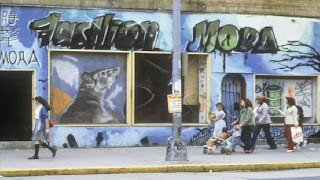Graffiti's Long History of Revitalizing the Bronx.
The following story from NY1 discussed the historical and social change impact of graffitti in the Bronx. We thought this story was relevant as we prepare for Artists Coming Together A.C.T., a project that will install permanent graffitti art in the 41st precinct in an effort to improve the quality of life in the area. Clicke the link below to view the video
Once Upon A Time In The Bronx: Fashion Moda Leaves Behind Artistic Mark
http://bronx.ny1.com/content/top_stories/124265/once-upon-a-time-in-the-bronx--fashion-moda-leaves-behind-artistic-mark
As the station continues its week-long look at the history of the Bronx, one local photographer recently shared her photo archives of an art gallery that many say made a difference in the borough. NY1's Dean Meminger filed the following report.
In the midst of the abandoned and burnt out buildings of the South Bronx during the 1970s and 1980s some artists found beauty. They saw something intriguing in all the despair and rubble.
"It felt important okay? It also felt permanent because it was so devastated. It was like how are they going to bring this back. But it felt important," said photographer Lisa Kahane.
Kahane's book titled "Do Not Give Way to Evil: Photographs of the South Bronx 1979 to 1987" illustrates the horror and hope of the borough. She was a photographer for a groundbreaking place called Fashion Moda, which opened in 1978 along the shopping district on Third Avenue. It was a gallery and performance space built on the theme of science, art, invention, technology and fantasy.
"Who is allowed to make art, who defines what art is, who gets to see it. Why does it always have to be situated in one neighborhood rather than another," Kahane said.
A lot of people from Downtown Manhattan ran the studio and invited their artist friends, like Keith Baring, up to the Bronx where they honed their styles. But the gallery was open to all, a sort of racial equality in art. Moda is the the Spanish word for fashion. And those in the South Bronx had their own fashion and art style.
"They would say. 'Oh well I have paintings can I bring them?' Yeah, sure bring them. And there was a South Bronx show every year," Kahane said.
In 1980, Fashion Moda was one of the first studios to open its doors to graffiti artists who had been making a big name for themselves on subway cars.
"This was wildly popular with the hundreds of kids who were doing graffiti in the neighborhood," Kahane said.
Some of the artwork and sculptures from Fashion Moda are actually still on display in the Bronx, including a series of castings of real people titled "We Are Family." The display was created in 1982 at Fashion Moda by artist John Ahearn.
"So we did the casting right on that stage. And after I did one casting, I realized that this was heaven, this was fantastic," Ahearn said. "As we would finish each one, we would put them on the wall. And as they accumulated, they would become the South Bronx hall of fame."
Fashion Moda closed its doors in the early 1990s, but its legacy and spirit lives on.
Once Upon A Time In The Bronx: Fashion Moda Leaves Behind Artistic Mark
http://bronx.ny1.com/content/top_stories/124265/once-upon-a-time-in-the-bronx--fashion-moda-leaves-behind-artistic-mark
As the station continues its week-long look at the history of the Bronx, one local photographer recently shared her photo archives of an art gallery that many say made a difference in the borough. NY1's Dean Meminger filed the following report.
In the midst of the abandoned and burnt out buildings of the South Bronx during the 1970s and 1980s some artists found beauty. They saw something intriguing in all the despair and rubble.
"It felt important okay? It also felt permanent because it was so devastated. It was like how are they going to bring this back. But it felt important," said photographer Lisa Kahane.
Kahane's book titled "Do Not Give Way to Evil: Photographs of the South Bronx 1979 to 1987" illustrates the horror and hope of the borough. She was a photographer for a groundbreaking place called Fashion Moda, which opened in 1978 along the shopping district on Third Avenue. It was a gallery and performance space built on the theme of science, art, invention, technology and fantasy.
"Who is allowed to make art, who defines what art is, who gets to see it. Why does it always have to be situated in one neighborhood rather than another," Kahane said.
A lot of people from Downtown Manhattan ran the studio and invited their artist friends, like Keith Baring, up to the Bronx where they honed their styles. But the gallery was open to all, a sort of racial equality in art. Moda is the the Spanish word for fashion. And those in the South Bronx had their own fashion and art style.
"They would say. 'Oh well I have paintings can I bring them?' Yeah, sure bring them. And there was a South Bronx show every year," Kahane said.
In 1980, Fashion Moda was one of the first studios to open its doors to graffiti artists who had been making a big name for themselves on subway cars.
"This was wildly popular with the hundreds of kids who were doing graffiti in the neighborhood," Kahane said.
Some of the artwork and sculptures from Fashion Moda are actually still on display in the Bronx, including a series of castings of real people titled "We Are Family." The display was created in 1982 at Fashion Moda by artist John Ahearn.
"So we did the casting right on that stage. And after I did one casting, I realized that this was heaven, this was fantastic," Ahearn said. "As we would finish each one, we would put them on the wall. And as they accumulated, they would become the South Bronx hall of fame."
Fashion Moda closed its doors in the early 1990s, but its legacy and spirit lives on.

Comments